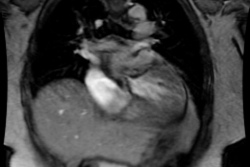Aneurysm of the Ductus Arteriosus:
Clinical:
Aneurysm of the ductus arteriosus is a RARE entity in adults. The ductus is a short tubular connection between the left pulmonary artery and the aorta. It is a remnant of the left sixth aortic arch which undergoes physiologic closure after birth. The ductus normally decreases in size during the first 10 to 15 hours after birth due to a decrease in pulmonary arterial pressure and contraction of the muscles in the duct wall. Anatomic closure occurs during the next 2 to 3 weeks with non-thrombotic obliteration originating on the pulmonary side. When closure is incomplete, the aortic side of the ductus will remain open. Many adults with ductus aneurysms are hypertensive and the long stnading exposure to high systemic pressure may be responsible for the subsequent dilatation and aneurysm formation. Most lesions come to medical attention as a result of an abnormality detected on CXR. Symptoms, if present, are usually related to mass effect and include dysphonia (due to compression of the left recurrent laryngeal nerve), cough, or dyspnea. Complications such as rupture, dissection, distal embolization, and hemorrhage due to fistulous communication with the bronchus or esophagus have been described. The lesion has been associated with aortic coarctation, aortic valvular disease, and Marfan's syndrome. The lesion has a 60% fatality rate. Treatment is resection.X-ray:
An aneurysm of the ductus arteriosus appears as an AP window mass or change in aortic arch contour on CXR. Findings which aid in the diagnosis include linear calcification at the periphery of the lesion, mottle calcification along it's aortic side, or a small pedicle linking the lesion to the pulmonary artery. Computed tomography will demonstrate a saccular, enhancing lesion arising from the aortic arch. CT may demonstrate calcification not evident on plain film and can also reveal thrombus within the lesion. Contrast enhancement may not be appreciated on CT if the ductus is non-patent. Angiography will demonstrate the origin of the lesion just beyond the origin of the left subclavian artery. Differential considerations based upon the plain film findings includes a cystic hygroma, ectopic thymus, duplication cyst, or lymphadenopathy.
(1) AJR 1991; Eschelman DJ, et al. General diagnosis case of the day: Aneurysm of the ductus arteriosus. 156: 1288-1294





